
PSILOCYBIAN MUSHROOMS IN NEW ZEALAND
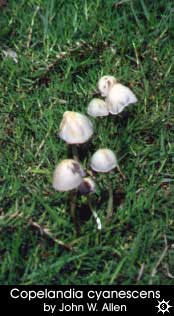 Until the late 1970's, the fact that psilocybin
containing mushrooms grew in New Zealand (NZ) was known to very few. The
perception of those interested in psychedelic drugs was that `magic
mushrooms' were an Australian phenomena, and that the only mushrooms of
this nature to be found in NZ had arrived via the post. Indeed, all of the
analyses performed by the Department of Scientific and Industrial Research
(DSIR) for the police at this time were upon P. cubensis which had
been sent to NZ in the mail, and intercepted by customs. Not until the
early l980's did a more general awareness appear, within the psychedelic
drug-using subculture, that psilocybin containing mushrooms could be found
in both islands of NZ. It is likely that persons experienced with the
Australian situation recognized C. cyanescens and P.
tasmaniana growing in the New Plymouth sand dunes, particularly at
Khomenii beach which is popular with surfers. At about the same time, a
botanist from the United Kingdom recognized P. semilanceata
(liberty cap) growing on the Otago peninsula, near the city of Dunedin in
the South Island. The botanist informed a circle of friends with an
interest in psychedelics, and the knowledge spread rapidly by word of
mouth.
Until the late 1970's, the fact that psilocybin
containing mushrooms grew in New Zealand (NZ) was known to very few. The
perception of those interested in psychedelic drugs was that `magic
mushrooms' were an Australian phenomena, and that the only mushrooms of
this nature to be found in NZ had arrived via the post. Indeed, all of the
analyses performed by the Department of Scientific and Industrial Research
(DSIR) for the police at this time were upon P. cubensis which had
been sent to NZ in the mail, and intercepted by customs. Not until the
early l980's did a more general awareness appear, within the psychedelic
drug-using subculture, that psilocybin containing mushrooms could be found
in both islands of NZ. It is likely that persons experienced with the
Australian situation recognized C. cyanescens and P.
tasmaniana growing in the New Plymouth sand dunes, particularly at
Khomenii beach which is popular with surfers. At about the same time, a
botanist from the United Kingdom recognized P. semilanceata
(liberty cap) growing on the Otago peninsula, near the city of Dunedin in
the South Island. The botanist informed a circle of friends with an
interest in psychedelics, and the knowledge spread rapidly by word of
mouth.Thus, it was not until l982 that articles with titles such as `Magic Mushroom Danger Warning' (Unsigned l982) began to appear in the press, and occasional reports of prosecutions appeared. As in Australia, media reports were usually quite inaccurate in describing the effects of the mushrooms, while giving precise instructions as to where they could be found. For example, in the aforementioned `Danger warning' (Unsigned, l982), a New Plymouth-based alcohol and drug abuse officer is quoted as saying that "it (the mushroom effect) was like setting off a time bomb..... most common was an instant `high' which put stress on the respiratory and heart functions....." The article goes on to say: "They were very dangerous, he warned. People had died from them." At the same time, there were reports on national television showing mushrooms being picked in the New Plymouth paddocks. Consequently, there was a sudden and dramatic increase in popular knowledge of the mushrooms, resulting in large-scale autumnal pilgrimages to this area of the country.
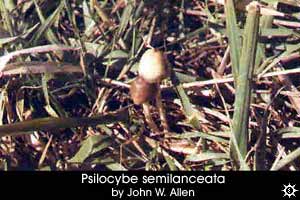 As in the U.S.A., the New Zealand police were not
vigorous in attempting to prosecute mushroom pickers, and tended to avoid
involvement unless specifically called by a farmer. Attempts to prosecute
cases were hampered by the wording of the Misuse of Drugs Act, l975, which
declared Psilocybe mexicana Heim and P. cubensis, neither of
which have ever been found growing in NZ (although the latter has been
intercepted in the incoming mail), to be prohibited plants, while
psilocybine and psilocine were class A substances. Most judges, with one
notable exception (Unsigned l986) felt that a mushroom was not a substance
(chemical) and thus prosecutions tended to fail. For this reason, an
Amendment to the Act was passed in early l988 which declared that all
members of the genera Psilocybe and Panaeolus were prohibited plants. This
has not, however, led to a marked increase in prosecutions and sentences
continue to be mild.
As in the U.S.A., the New Zealand police were not
vigorous in attempting to prosecute mushroom pickers, and tended to avoid
involvement unless specifically called by a farmer. Attempts to prosecute
cases were hampered by the wording of the Misuse of Drugs Act, l975, which
declared Psilocybe mexicana Heim and P. cubensis, neither of
which have ever been found growing in NZ (although the latter has been
intercepted in the incoming mail), to be prohibited plants, while
psilocybine and psilocine were class A substances. Most judges, with one
notable exception (Unsigned l986) felt that a mushroom was not a substance
(chemical) and thus prosecutions tended to fail. For this reason, an
Amendment to the Act was passed in early l988 which declared that all
members of the genera Psilocybe and Panaeolus were prohibited plants. This
has not, however, led to a marked increase in prosecutions and sentences
continue to be mild.NZ is an isolated country with a prolific native flora. While the importation of cattle may have been responsible for introducing P. cyanescens to NZ, there are at least five indigenous species, four of which have yet to be described in detail and named (Johnson and Buchanan l988, D.S.I.R., Pers. Comm.). The fifth is Psilocybe novo zealandiae, which has been characterized by Guzmán (l983). P. novo zealandiae is found primarily in the native forests of the southern South Island, and as such is unlikely to have played a significant role in human ingestion. This latter species is not psychoactive.
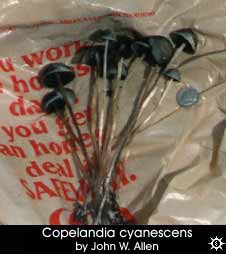 Copelandia cyanescens (`blue meanies')
predominates in the New Plymouth region, an area of intensive dairy
farming. The mushrooms appear in autumn, most commonly under lupine bushes
in coastal paddocks. In the lower South Island, particularly the Otago
area and Dunedin city, the species consumed by users is P.
semilanceata (`liberty cap').
Copelandia cyanescens (`blue meanies')
predominates in the New Plymouth region, an area of intensive dairy
farming. The mushrooms appear in autumn, most commonly under lupine bushes
in coastal paddocks. In the lower South Island, particularly the Otago
area and Dunedin city, the species consumed by users is P.
semilanceata (`liberty cap').In so far as epithets are concerned, the most popular term is `magic mushrooms.' Neither the Australian term `gold tops' nor the English and American `liberty caps' has been widely adopted, although the term `blue meanies' is occasionally used to refer to P. cyanescens. In a study involving in depth interviews (and follow up questionnaires) of 150 people, carried out between l982 and l989 all over NZ (Jansen, Pers. Comm. l989) it was clear that many users knew that `gold tops' referred to an "Australian" mushroom (P. cubensis) which was different from those used in NZ.
In the study referred to above, the only case requiring emergency room treatment was a musician who, due to impaired coordination, had fallen and cut his head. The hospital staff were not told of his intoxication, he was sutured without difficulty, and departed the emergency room with his companions. All persons in the study were asked if they knew of anyone who had required acute medical treatment, and except for the case discussed above there were no other instances known to those in the sample. According to Dr. K. L. R. Jansen, there are no reported case histories in the NZ medical literature. However, 3 out of the 150 cases (Approximately 2%) suffered prolonged psychological difficulties following their mushroom experiences. Two of these cases involved the precipitation of a severe paranoid psychosis, eventually requiring psychiatric treatment which was still in progress at the time of the interview. In both cases there were obvious predisposing features, but there was clearly no pre-existing psychosis while following the mushroom experiences there was frank and prolonged psychosis. These cases illustrate the point which has often been made concerning psychedelic drugs: that there are certain persons who are psychologically at serious risk from these substances, and must be urged to avoid them.
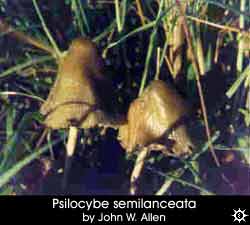 In terms of physical effects, no evidence was
found to support the claims made in the `Danger Warning' that psilocybian
mushrooms placed a major stress on the heart and respiratory systems, nor
is there any evidence of any deaths occurring in NZ due to psilocybian
mushroom ingestion. The potentially lethal practice of driving back to
Auckland city from New Plymouth while intoxicated on mushrooms has not yet
resulted in a serious accident. There were several descriptions of a very
rapid start to the altered state which might be described as an `instant
high', but nothing to indicate that this was a serious threat to
health.
In terms of physical effects, no evidence was
found to support the claims made in the `Danger Warning' that psilocybian
mushrooms placed a major stress on the heart and respiratory systems, nor
is there any evidence of any deaths occurring in NZ due to psilocybian
mushroom ingestion. The potentially lethal practice of driving back to
Auckland city from New Plymouth while intoxicated on mushrooms has not yet
resulted in a serious accident. There were several descriptions of a very
rapid start to the altered state which might be described as an `instant
high', but nothing to indicate that this was a serious threat to
health.The major physical danger from ingesting psilocybin mushrooms in NZ arises from the use of fungicidal and other agricultural sprays (c.f., see Young et al l982), which have been used in both the North and the South Island by farmers and enforcement authorities. Karl L. R. Jansen, (a medical doctor from the University of Auckland) has attended a person at their home suffering from marked weakness of the respiratory muscles, with attendant shortness of breath, following ingestion of sprayed mushrooms. The signs and symptoms of poisoning continued for at least 18 hours after the return of a normal mental state, indicating that the muscle weakness was unlikely to have been due to psilocybin which may sometimes cause weakness acutely. Others ingesting the mushrooms from this paddock also suffered various forms of muscle weakness (e.g. lazy eyelid, which is extremely unlikely to have a `psychological' origin), extending in all cases for many hours beyond the end of the change in consciousness. In several cases, strong and robust men with extensive experience of psychedelic drugs collapsed while crossing the road due to severe muscle weakness - a potentially life-threatening situation. It is thus clear that spraying mushrooms represents a greater public health threat than the mushrooms themselves, and should be discontinued.
Finally, it was suggested by several persons in the study that the Maori (the indigenous race) may have used psilocybin mushrooms. This possibility was also mentioned by R.G. Wasson on a visit to NZ, in relation to the theory which holds that concepts of divinity may have arisen in primitive peoples out of psychedelic drug experiences. In fact, there is no evidence of any sort to support the use of these mushrooms by the pre-conquest Maori. The Maori are quite distinctive for having used no consciousness altering drugs of any kind, and were highly skilled at treating food to remove toxic substances. This conclusion was supported by all of NZ's Professors of Maori studies, and many other scholars of the Maori culture, in a series of consultations carried out in l988. It appears that the Maori culture represents at least one instance of a complex and rich theology and mythology, involving priests (tohunga's) and the frequent invocation of deities in daily life, which did not require the use of consciousness-altering chemicals.
SOME FINAL THOUGHTS
In Australia the majority of hallucinogenic fungi seem to occur in Queensland, New South Wales, Victoria, and to a lesser degree in South Australia; but several of the species, listed in Table 1, have been collected in all of the Australian States including Camberra, A.C.T. Hall, 1973; Southcott, 1974; Young, 1989; Shepherd and Totterdell, 1990; Allen, Merlin & Jansen, 1991; Stamets, 1996). Use of these fungi also occur on both the North and South Islands of New Zealand (Allen, J. W., Merlin, M. D. and K. L. R. Jansen, 1991; Stamets, 1996).
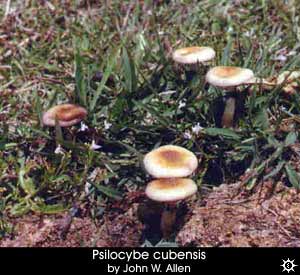 Published medical reports of cases involving
psilocybian mushroom poisoning are often confusing when presented by
individuals who are unaware of the particular species of mushrooms which
were consumed. Most dysphoric reactions apparently are the result of (1)
improper dosage (2) unfavorable set and setting or (3) emotional and
recurring psychological problems often associated with a past history of
poly-drug abuse. This has often hampered proper medical diagnosis,
resulting in delayed treatment, especially if the doctors cannot properly
identify the causative species involved.
Published medical reports of cases involving
psilocybian mushroom poisoning are often confusing when presented by
individuals who are unaware of the particular species of mushrooms which
were consumed. Most dysphoric reactions apparently are the result of (1)
improper dosage (2) unfavorable set and setting or (3) emotional and
recurring psychological problems often associated with a past history of
poly-drug abuse. This has often hampered proper medical diagnosis,
resulting in delayed treatment, especially if the doctors cannot properly
identify the causative species involved.From all the published material of the last century, we have come to the conclusion that the effects following the ingestion of Panaeolus spp. appear to be more tranquil and less intense than the sometimes overwhelming hallucinatory effects attributed to the consumption of certain species of Psilocybe, which may be frightening, sometimes causing dysphoria and confusion when taken in excessive dosages.
While arrests (Hall, 1973; Misuse of Drugs Act, 1975) for psilocybian mushrooms in Australia and New Zealand usually occur due to trespassing rather than possession of the fungi, it should be mentioned that in Florida, as in Great Britain and Holland, possession of fresh psilocybin mushrooms is currently not an illegal act (and cultivation of Psilocybe cubensis is legal in England and psilocybian mushrooms (fresh and dried, are now legally sold in Holland). Judges in these areas have ruled that psilocybine and psilocine are chemicals and mushrooms, regardless of any psychoactive content, are simply mushrooms. Although this is presently accepted, the law states that the chemical substances are illegal to possess. However, very few if any prosecutions take place in the United States, Great Britain, and Canada for these offense (except when arrests are made in regards to the illicit large cultivation of P. cubensis). This apparently is also true for both Australia and New Zealand.
 While much documentation exists in regards to the
users who sought medical treatment, it should be mentioned that many may
be afraid to seek medical aid because of fear of prosecution. A good
example of this is the teenager who died in Whidbey Island, Washington
from eating a poisonous variety of fungi which she thought was a Psilocybe
species. For more than two days she and her companions were afraid to
report their illness to the proper medical authorities, which resulted in
delayed treatment and death (Allen l988). Drug educators and those who are
involved in Drug Abuse programs, especially teachers in public schools,
should make aware to their students or patients that doctors and hospitals
will not report their activities to law enforcement agencies when treating
them for their drug habits.
While much documentation exists in regards to the
users who sought medical treatment, it should be mentioned that many may
be afraid to seek medical aid because of fear of prosecution. A good
example of this is the teenager who died in Whidbey Island, Washington
from eating a poisonous variety of fungi which she thought was a Psilocybe
species. For more than two days she and her companions were afraid to
report their illness to the proper medical authorities, which resulted in
delayed treatment and death (Allen l988). Drug educators and those who are
involved in Drug Abuse programs, especially teachers in public schools,
should make aware to their students or patients that doctors and hospitals
will not report their activities to law enforcement agencies when treating
them for their drug habits.There is also no evidence indicating that the sale of common, commercial mushrooms (e.g., Agaricus bisporis and/or A. campestris) adulterated with LSD or PCP are sold on the continent or in New Zealand. However, in 1978, Jonathan Ott reported that this was a common situation in the mainland United States for several years and may continue today. These fake "magic mushrooms have been referred to as Psilocybe hofmannii.
| [Index] | [Next
Page] |
|---|
| Last Modified - Sun, Oct 29, 2000 | Copyright 1999 John W. Allen and Erowid |
| [ Back to Psilocybin Mushroom Vault ] |
|---|
| [Plants
& Drugs] [Mind & Spirit]
[Freedom
& Law] [Arts &
Sciences] [Library] [Search] [About] (content and html © 2001 Erowid.org. Please ask permission before publicly reproducing.) |
|---|